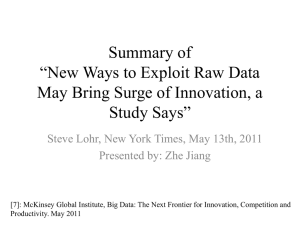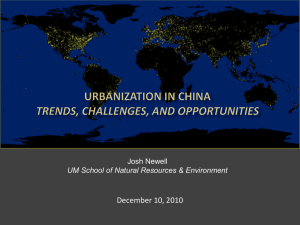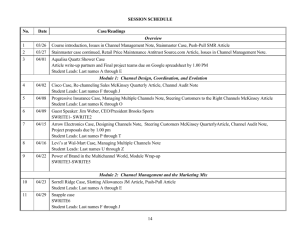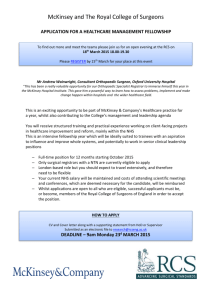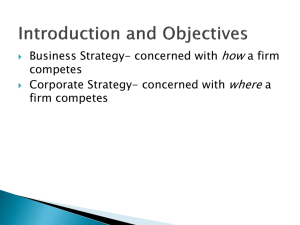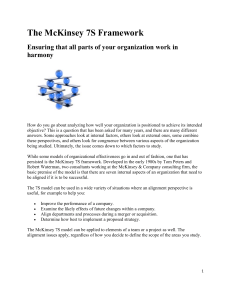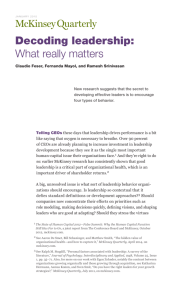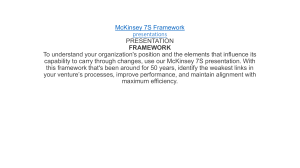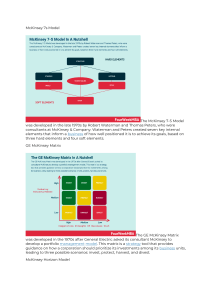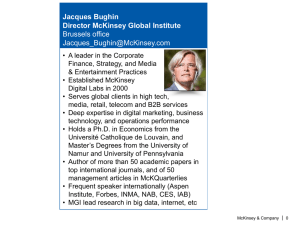Chapter6-Assessing countries attractiveness
advertisement
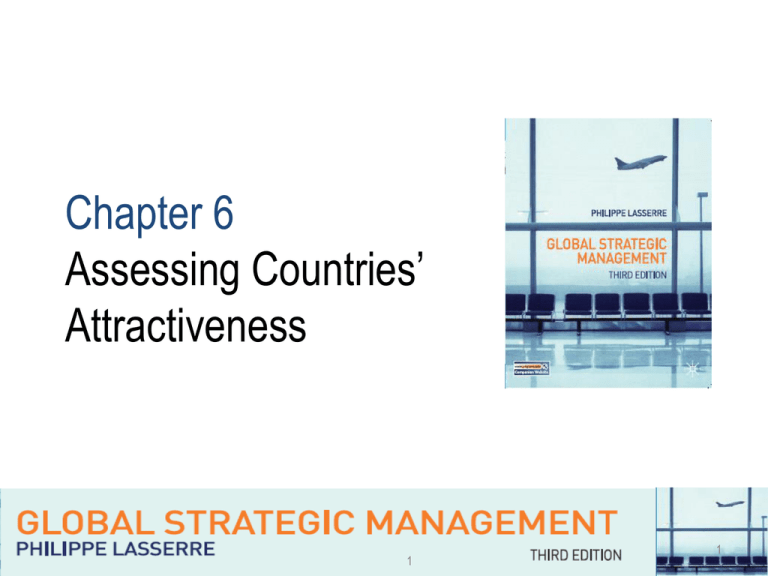
Chapter 6 Assessing Countries’ Attractiveness 1 1 The foreign markets entry decision-making 1 Analysis (Assessing Country Attractiveness) COUNTRY OPPORTUNITIES 2 COUNTRY RISK ANALYSIS 3 COMPETITIVE ANALYSIS 4 Implementation • External • Internal ENTRY MODE DEVELOPMENT PATHS 5 6 2 ORGANISATION:CONTROL What makes a country attractive for foreign investors? Country Size and Growth - Economic Factors - Demographic Factors - Public Policy Factors - Sociological Factors Resources Incentives - Is the country a critical source of • Skilled Personnel • Raw materials? • Components? • Labor? • Technological innovation? • Learning? -Taxes - Subsidies - Regulations - Government Contracts - Ease of Doing Business Industry Risks - Political -Economical -Competitive -Operational - Quality of Infrastructure and supporting services - Location 3 Market Nature of the demand in this country? -Life Cycle -Segmentation -Quality of demand Competition Intensity of Rivalry -Entry barriers - Bargaining Power of Suppliers and Customers Countries’ growth life cycle 12,00% China 10,00% Average Growth Rate 1990-2009 8,00% India M alaysia 6,00% Singapore Korea Chile 4,00% Hong Kong Indonesia Australia Philippines M exico South 2,00% Africa Brazil Russia 0,00% -1000 9000 USA France GermanyUK 19000 29000 -2,00% GDP/ Cap US$ 2009 (Circles are proportional to GDP) 4 39000 49000 Quality of markets: Segmentation 5 Middle class effect in emerging countries 6 Middle Class effect in China 158% VCRs 68% Washing machines 79% Refrigerators Growth 1990-1995 143% Televisions 605% Telephones 36% GNP/per cap 0% 100% 200% 300% 400% Source: : World Bank & EIU 7 500% 600% 700% Middle Class in India McKinsey Survey2007 60% 50% 2005 40% 2015 2025 30% 20% 10% 0% Thousand Rupiah Per Household 1US$=45.7Rp) 0 100 Deprived Below 90000Rp <2000US$ 200 “Aspirers” (90000-200000Rp) (2000-4400US$) 300 400 500 600 Low Middle Class “Seekers” ( 200000-500000 Rp) (4400-11000Us$) 700 800 Middle Class “Strivers” (500000-1000000Rp) (11000-21000US$) 900 1000 “Global” Above 1000000Rp >21000US$ Source: McKinsey: The 'Bird of Gold': The Rise of India's Consumer Market,2007 8 8 Middle Class in India McKinsey Survey2007 Total Population : Urban Population %: # of Urban household in Middle class Household size: Urban Middle Class Population: 1090 M 1250 M 1400 M 30% 35% 40% 8 49 94 5.4 5.1 5 43.2 249 470 9 Source: McKinsey: The 'Bird of Gold': The Rise of India's Consumer Market,2007 Is the business profitable in this country? Customer Value Competitive Forces Value Kept by Customer Price Value for Shareholders, Community (Taxes) , Employees (Bonuses) Costs Factor Costs Technology Management > Cost of Creating Value > Internal Costs Purchased Supplies Volume 10 Value Captured Profitability Drivers Sociological Factors Demographic Factors Demand Competitive Forces Public Policy Factors Economic Value Industry and Country Attractiveness Risks Economic Growth Company Competitive Advantages Sustainable Differentition Costs Advantages 11 Customer Value Innovation Is the business profitable? Porter’s Five Forces • Imitative behaviour: Barriers to Entry • Legal: licenses • Partnering • Distribution • Complexity of Competitive Context Suppliers New Entrants – Overcapacity Leading to: – Undifferentiated competitive approaches – Price based competition – Protected local firms – Intricated networks Intensity of Rivalry and Competition • Local Content requirements create monopolies Buyers • Price conscious The sixth force: Government • Protected suppliers gives them high bargaining power Source: Michael E. Porter when a business is perceived as lucrative many competitors jump at it Substitutes 12 • Protectionism • Import Substitution • Strong regulation Is the business risky? ISD 6 13 Countries’ Risks Source: Global Insight, 2010 14 14 Relationship between country risks and Foreign Direct Investments Source: UNCTAD for FDI and Global Insight for Risks 15 15 Assessing Country Risks Methods: Issues: Lessons: Grand Tour Banks Consultants Trade Commissions Ratings Intelligence building Availability of data Reliability of data Bias Cultures Don’t rely on one single source Don’t delegate the interpretation to third parties Invest in intelligence Look at operational issues 16 Ease of Doing Business Economy Ease of Doing Business Rank Dealing with Construction Permits Starting a Business Singapore 1 4 Hong Kong 2 5 Korea, Rep. 8 24 Japan 20 107 Taiwan 25 Denmark Norway United Kingdom Sweden Germany Switzerland Getting Electricity 3 Registering Property Getting Credit 5 14 8 1 4 57 4 26 11 71 8 63 26 58 24 16 87 3 33 5 31 10 13 6 41 60 12 7 19 22 60 14 46 23 8 19 98 15 26 85 46 France 29 25 South Africa 35 China 91 Russia 120 Brazil 126 India 132 Protecting Investors Paying Taxes Enforcing Contracts Resolving Insolvency 4 1 12 2 3 3 2 5 16 79 38 4 2 13 17 120 16 34 1 67 79 71 23 88 14 11 24 29 14 7 32 9 8 48 24 27 9 4 4 68 1 10 24 13 21 6 19 48 29 50 8 54 19 2 77 24 97 89 12 8 36 6 14 24 166 12 41 23 43 30 62 149 48 79 58 24 6 46 44 31 124 76 1 10 44 144 81 77 151 179 115 40 67 97 122 60 16 75 111 178 183 45 98 111 105 160 13 60 120 127 51 114 98 79 150 121 118 136 166 181 98 97 40 46 147 109 182 128 Source: Woldd Bank, http://www.doingbusiness.org/EconomyRankings/ 17 2 Trading Across Borders

